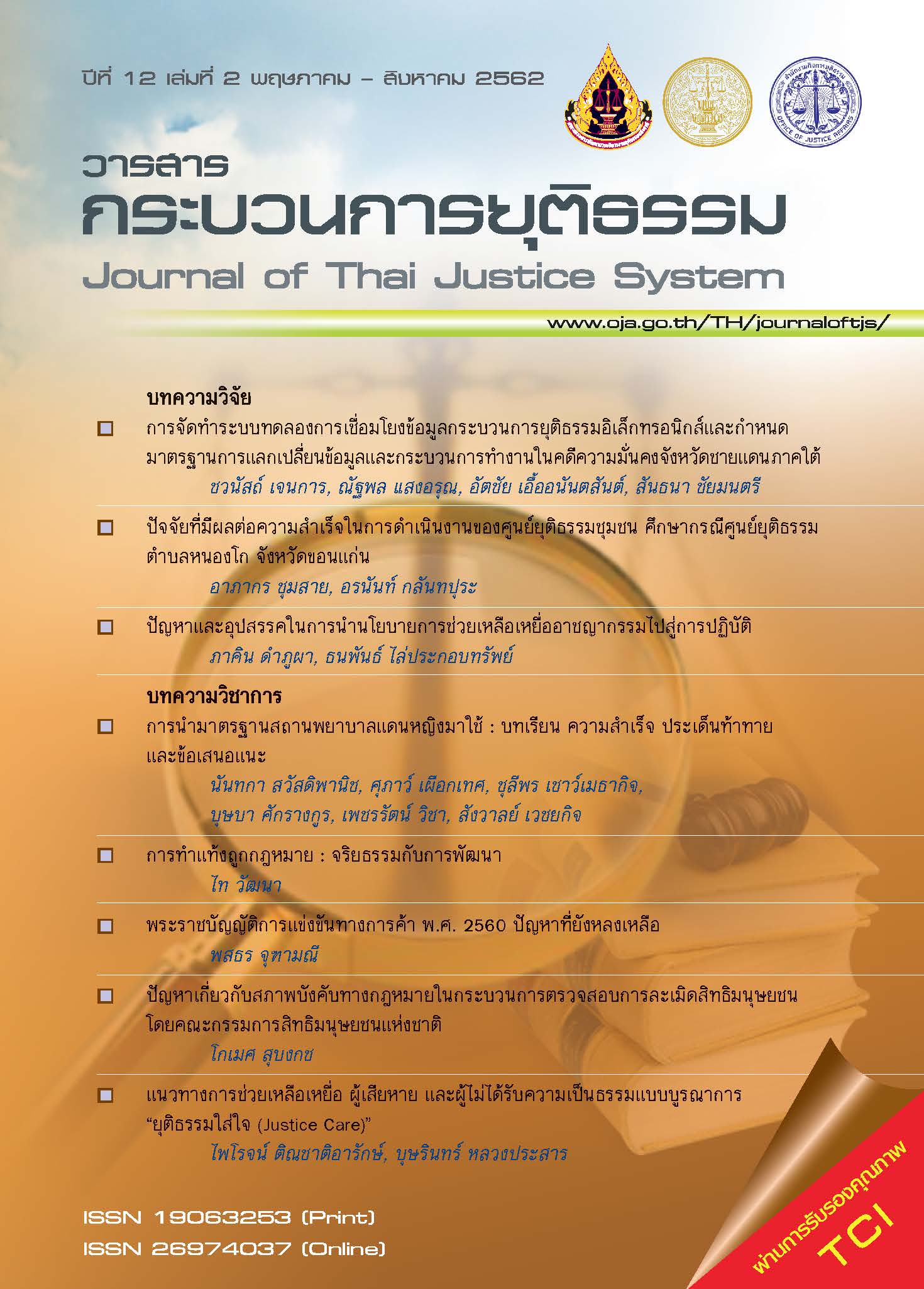การนำมาตรฐานสถานพยาบาลแดนหญิงมาใช้ : บทเรียนความสำเร็จ ประเด็นท้าทาย และข้อเสนอแนะ
Main Article Content
บทคัดย่อ
มาตรฐานสถานพยาบาลแดนหญิงมี 3 ด้าน คือ 1) มาตรฐานการบริหารจัดการสถานพยาบาลแดนหญิง 2) มาตรฐานการจัดบริการด้านสุขภาพในแดนหญิง และ 3) มาตรฐานเชิงผลลัพธ์จากการจัดบริการด้านสุขภาพในแดนหญิง เป็นเครื่องมือในการพัฒนาการจัดบริการด้านสุขภาพสำหรับผู้ต้องขังหญิงและเด็กติดผู้ต้องขังที่สอดคล้องกับข้อกำหนดกรุงเทพฯ และพระราชบัญญัติราชทัณฑ์ พ.ศ. 2560 จากประสบการณ์การนำมาตรฐานสถานพยาบาลแดนหญิงมาใช้ในสถานพยาบาล ทัณฑสถานหญิงเชียงใหม่ มีบทเรียนความสำเร็จเกิดขึ้น โดย 1) ด้านโครงสร้างมีการปรับปรุงทางกายภาพของสถานพยาบาล จัดหาวัสดุอุปกรณ์ ครุภัณฑ์ทางการแพทย์ มีนโยบายการดูแลสุขภาพและการพัฒนาบุคลากรที่ชัดเจน รวมทั้งแสวงหางบประมาณการดูแลสุขภาพเพิ่มเติม 2) ด้านกระบวนการ จัดบริการด้านสุขภาพครบ 4 มิติการดูแล ภายใต้การทำงานร่วมกัน
ของเจ้าหน้าที่ในเรือนจำกับเครือข่ายภายนอก มีการจัดทำและดำเนินการตามแนวปฏิบัติ พัฒนาระบบการจัดเก็บและวิเคราะห์ข้อมูลด้านสุขภาพ 3) ด้านผลลัพธ์การจัดบริการด้านสุขภาพ มีการประเมินความพึงพอใจของผู้ต้องขังหญิงและมีการนำข้อมูลที่บันทึกมาประมวลเป็นสถิติเพื่อสะท้อนคุณภาพการดูแลสุขภาพ
ที่ชัดเจนขึ้น สำหรับประเด็นท้าทายที่ควรปรับปรุงในการนำมาตรฐานสถานพยาบาลแดนหญิงมาใช้ คือ
1) การขาดแคลนอัตรากำลัง 2) ความไม่เพียงพอของงบประมาณ 3) การส่งเสริมสุขภาพจิตและการตรวจ
คัดกรองโรคในกลุ่มเสี่ยงดำเนินการได้น้อย จากบทเรียนความสำเร็จของทัณฑสถานหญิงเชียงใหม่ มีข้อเสนอแนะสำหรับเรือนจำอื่นเพื่อการนำมาตรฐานสถานพยาบาลแดนหญิงไปใช้และทำให้เกิดความยั่งยืน คือ 1) ควรมีการติดตั้งระบบและกลไกในการพัฒนาคุณภาพการจัดบริการด้านสุขภาพ 2) เน้นการสร้างเครือข่ายภายนอกอย่างต่อเนื่อง 3) เพิ่มนโยบายการส่งเสริมสุขภาพกายและสุขภาพจิต 4) แสวงหาอัตรากำลังพยาบาลและเจ้าหน้าที่ราชทัณฑ์ที่เกี่ยวข้องกับการจัดบริการด้านสุขภาพอย่างเพียงพอและ 5) แสวงหางบประมาณการดูแลสุขภาพผู้ต้องขังโดยการประสานความร่วมมือกับเครือข่ายภายนอก
Article Details
ต้นฉบับที่ได้รับการตีพิมพ์ในวารสาร เป็นลิขสิทธิ์ของวารสารกระบวนการยุติธรรม แต่ความคิดเห็นที่ปรากฏในเนื้อหาของบทความในวารสารกระบวนการยุติธรรม ถือเป็นความรับผิดชอบของผู้เขียนแต่เพียงผู้เดียว
เอกสารอ้างอิง
กองการพยาบาล สำนักงานปลัดกระทรวงสาธารณสุข. (2544). มาตรฐานการพยาบาลในชุมชน (พิมพ์ครั้งที่ 2).
กรุงเทพฯ: โรงพิมพ์ยูไนเต็ดโปรดักชั่น.
กองบริการทางการแพทย์. (2547). ข้อมาตรฐานและคำอธิบายมาตรฐานสิ่งจำเป็นขั้นพื้นฐานการใช้ชีวิในเรือนจำสำหรับผู้ต้องขัง. นนทบุรี: กรมราชทัณฑ์.
คณะทำงานพัฒนาสถานพยาบาลแดนหญิงในเรือนจำทัณฑสถานหญิง วิทยาลัยพยาบาลสภากาชาดไทย. (2558). คู่มือเกณฑ์และการประเมินสถานพยาบาลแดนหญิง. กรุงเทพฯ: บางกอกบล็อก.
นันทกา สวัสดิพานิช, พิไลลักษณ์ โรจนประเสริฐ, ศุภาว์ เผือกเทศ, พิมพิไล ทองไพบูลย์, และสุภาพร วรรณสันทัด.
(2557). การพัฒนามาตรฐานการบริการพยาบาลในแดนหญิงในเรือนจำ/ทัณฑสถานหญิง
(รายงานการวิจัย). กรุงเทพฯ: สำนักกิจการในพระดำริ พระเจ้าหลานเธอพระองค์เจ้าพัชรกิติยาภา.
พระราชบัญญัติราชทัณฑ์พุทธศักราช 2560. (2560). ราชกิจจานุเบกษา. 134 (21ก), 63-70.
วสันต์ ศิลปะสุวรรณ, และพิมพ์พรรณ ศิลปสุวรรณ. (2541). การวางแผนและประเมินผลโครงการ
ส่งเสริมสุขภาพ : ทฤษฏีและการปฏิบัติ. กรุงเทพฯ: คณะสาธารณสุขศาสตร์ มหาวิทยาลัยมหิดล.
ศุภาว์ เผือกเทศ, นันทกา สวัสดิพานิช, เดือนทิพย์ เขษมโอภาส, สุจรรยา โลหาชีวะ, พิมพิไล ทองไพบูลย์, พิไลลักษณ์ โรจนประเสริฐ, วรุณยุพา รอยกุลเจริญ และคณะ. (2560). การวิเคราะห์แนวทางการพัฒนาสถานพยาบาลแดนหญิงในเรือนจำ. วารสารสภาการพยาบาล, 32(1). 94-114.
สภาการพยาบาล. (2548). ประกาศสภาการพยาบาลเรื่องมาตรฐานการบริการพยาบาลและการผดุงครรภ์ ในระดับปฐมภูมิ. ราชกิจจานุเบกษา. 122 (62 ง), 63–70.
สำนักบริหารการสาธารณสุข สำนักงานปลัดกระทรวงสาธารณสุข กระทรวงสาธารณสุข. (2559). แนวทาง การพัฒนาระบบบริการสุขภาพผู้ต้องขังในเรือนจำ. ค้นจาก https://phdb.moph.go.th/
หนังสือต่างประเทศ
Donabedian, A. (1988). The quality of care. How can it be assessed?. JAMA, 260(12). 1743-1748.
International Council of Nurses. (2011). Position statement: Nurse’s role in the care of detainees and prisoners. Geneva.


